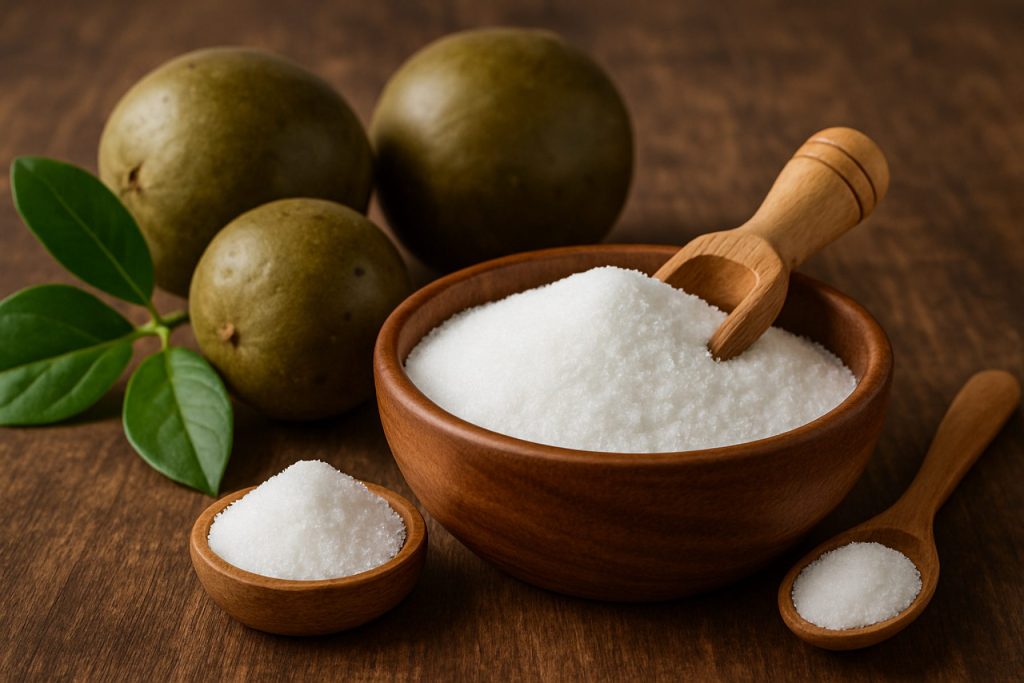
Discover the Power of Monkfruit Sweetener: A Deep Dive Into Its Health Benefits, Uses, and Why It’s Taking Over the Sugar Substitute Market. Uncover the Science and Secrets Behind This All-Natural Sweetener.
- What Is Monkfruit Sweetener? Origins and Extraction
- Nutritional Profile and Health Benefits
- How Monkfruit Sweetener Compares to Sugar and Other Alternatives
- Potential Side Effects and Safety Considerations
- Culinary Uses: Baking, Cooking, and Beverages
- Monkfruit Sweetener in Special Diets (Keto, Diabetic, etc.)
- Market Trends and Consumer Insights
- Tips for Choosing and Using Monkfruit Sweetener
- Sources & References
What Is Monkfruit Sweetener? Origins and Extraction
Monkfruit sweetener, also known as luo han guo extract, is a natural, zero-calorie sugar substitute derived from the fruit of Siraitia grosvenorii, a small melon native to southern China. The fruit has been used for centuries in traditional Chinese medicine, primarily for its purported health benefits and natural sweetness. The intense sweetness of monkfruit comes from unique antioxidants called mogrosides, which are present in the fruit’s flesh.
The extraction process begins with harvesting ripe monkfruit, which is then crushed to release its juice. The juice is filtered and subjected to a series of purification steps to isolate the mogrosides, removing most of the fruit’s natural sugars and other plant material. The resulting extract is up to 200 times sweeter than table sugar, yet it contains no calories or carbohydrates, making it a popular choice for those seeking to reduce sugar intake or manage blood glucose levels. The final product is often blended with other ingredients, such as erythritol or dextrose, to balance sweetness and improve texture for culinary use.
Monkfruit sweetener’s rise in global popularity is closely linked to increasing consumer demand for natural, low-calorie alternatives to sugar. Regulatory agencies such as the U.S. Food and Drug Administration and European Food Safety Authority have recognized monkfruit extract as generally safe for consumption, further supporting its adoption in food and beverage products worldwide.
Nutritional Profile and Health Benefits
Monkfruit sweetener, derived from the fruit of Siraitia grosvenorii, is valued for its intense sweetness and negligible caloric content. The primary sweetening compounds, mogrosides, are non-nutritive, meaning they provide sweetness without contributing significant calories or carbohydrates. This makes monkfruit sweetener particularly attractive for individuals managing diabetes or following low-carbohydrate diets, as it does not raise blood glucose or insulin levels according to studies reviewed by the U.S. Food and Drug Administration.
Nutritionally, monkfruit sweetener contains virtually no macronutrients—no fat, protein, or digestible carbohydrates. It is also free from artificial additives and is considered safe for consumption by children, pregnant women, and people with diabetes. The mogrosides in monkfruit have demonstrated antioxidant properties in laboratory studies, suggesting potential benefits in reducing oxidative stress and inflammation, as noted by the National Institutes of Health. However, more human studies are needed to confirm these effects in everyday dietary use.
Unlike some other non-nutritive sweeteners, monkfruit does not typically cause digestive discomfort or alter gut microbiota, making it a well-tolerated alternative for those sensitive to sugar alcohols. Its clean, sweet taste profile and lack of aftertaste further enhance its appeal as a sugar substitute in both home and commercial food preparation, as recognized by the European Food Safety Authority.
How Monkfruit Sweetener Compares to Sugar and Other Alternatives
Monkfruit sweetener stands out among sugar substitutes due to its unique properties and health profile. Unlike table sugar (sucrose), which contains 4 calories per gram and causes rapid spikes in blood glucose, monkfruit sweetener is calorie-free and does not raise blood sugar levels, making it suitable for people with diabetes or those following low-carbohydrate diets. The sweetness of monkfruit is derived from mogrosides, natural compounds that are estimated to be 100–250 times sweeter than sucrose, allowing for much smaller quantities to achieve the same level of sweetness U.S. Food and Drug Administration.
Compared to other popular alternatives, such as stevia and erythritol, monkfruit sweetener is often praised for its clean, non-bitter aftertaste. Stevia, another plant-derived sweetener, can sometimes impart a licorice-like or bitter flavor, while sugar alcohols like erythritol may cause digestive discomfort in sensitive individuals. Monkfruit, on the other hand, is generally well-tolerated and does not have these side effects National Center for Complementary and Integrative Health.
In terms of culinary use, monkfruit sweetener is heat-stable, making it suitable for baking and cooking. However, it lacks the bulk and browning properties of sugar, so recipes may require adjustments. Overall, monkfruit sweetener offers a natural, zero-calorie alternative to sugar and other substitutes, with a favorable safety and taste profile U.S. Food and Drug Administration.
Potential Side Effects and Safety Considerations
Monkfruit sweetener is generally recognized as safe for consumption by major regulatory agencies, including the U.S. Food and Drug Administration and the European Food Safety Authority. It is considered non-toxic, non-carcinogenic, and does not appear to cause adverse effects in the general population when consumed within typical dietary amounts. However, as with any food additive, there are some considerations regarding its safety and potential side effects.
Most individuals tolerate monkfruit sweetener well, as it does not contain calories or carbohydrates and does not raise blood glucose levels, making it suitable for people with diabetes or those following low-carb diets. Allergic reactions to monkfruit are rare, but individuals with known allergies to members of the gourd family (Cucurbitaceae) should exercise caution, as monkfruit is botanically related to cucumbers and melons.
Some commercially available monkfruit sweeteners are blended with other ingredients, such as erythritol or dextrose, to improve texture and sweetness. These additives may cause digestive discomfort, such as bloating or gas, particularly in sensitive individuals or when consumed in large quantities. It is important to read product labels to identify any additional ingredients that may contribute to side effects.
Current research has not identified any significant long-term health risks associated with monkfruit sweetener. Nonetheless, as with all novel food ingredients, ongoing monitoring and research are recommended to ensure continued safety for all population groups (National Institutes of Health).
Culinary Uses: Baking, Cooking, and Beverages
Monkfruit sweetener has gained popularity as a versatile sugar substitute in a wide range of culinary applications, particularly for those seeking to reduce caloric intake or manage blood sugar levels. In baking, monkfruit sweetener can be used as a direct replacement for sugar in many recipes, including cakes, cookies, muffins, and quick breads. Its heat stability ensures that it retains its sweetness even at high temperatures, making it suitable for both home and commercial baking. However, because monkfruit sweetener lacks the bulk and caramelization properties of sugar, some recipes may require adjustments, such as adding extra moisture or combining it with bulking agents like erythritol for optimal texture and browning U.S. Food & Drug Administration.
In cooking, monkfruit sweetener can be incorporated into sauces, marinades, and dressings, providing sweetness without the added calories. It dissolves easily in both hot and cold liquids, making it a practical choice for sweetening beverages such as coffee, tea, smoothies, and cocktails. Because monkfruit sweetener is much sweeter than sugar—often 100 to 250 times sweeter—recipes typically require only a small amount, and many commercial products blend monkfruit extract with other ingredients to achieve a sugar-like consistency and sweetness level British Nutrition Foundation.
Overall, monkfruit sweetener offers a flexible, low-calorie alternative for sweetening a variety of foods and drinks, though users may need to experiment with quantities and combinations to achieve the desired taste and texture in different culinary contexts.
Monkfruit Sweetener in Special Diets (Keto, Diabetic, etc.)
Monkfruit sweetener has gained significant popularity among individuals following special diets, particularly ketogenic (keto) and diabetic meal plans. Its appeal lies in its zero-calorie, zero-carbohydrate profile, which does not raise blood glucose or insulin levels. This makes it an attractive alternative to sugar for people managing diabetes or those seeking to maintain ketosis, a metabolic state crucial for the keto diet. Unlike some artificial sweeteners, monkfruit extract is derived from the fruit of Siraitia grosvenorii and contains natural compounds called mogrosides, which provide intense sweetness without the caloric impact of sugar.
For individuals with diabetes, monkfruit sweetener offers a way to enjoy sweet flavors without the risk of blood sugar spikes. Clinical and regulatory reviews have found that monkfruit extract does not affect glycemic response, making it a safe option for diabetic diets American Diabetes Association. Similarly, those on the keto diet benefit from monkfruit’s lack of digestible carbohydrates, which helps maintain low daily carb intake and supports ketosis Diet Doctor.
Monkfruit sweetener is also suitable for other special diets, including paleo and vegan, as it is plant-derived and typically free from animal products and common allergens. However, consumers should check product labels for added fillers or bulking agents, which may not align with all dietary restrictions. Overall, monkfruit sweetener’s versatility and metabolic neutrality make it a valuable tool for those adhering to specialized nutritional regimens.
Market Trends and Consumer Insights
The market for monkfruit sweetener has experienced significant growth in recent years, driven by increasing consumer demand for natural, low-calorie sugar alternatives. Health-conscious consumers, particularly those managing diabetes or seeking to reduce sugar intake, are fueling this trend. According to Grand View Research, the global monkfruit sweetener market size was valued at over USD 720 million in 2022 and is projected to expand at a compound annual growth rate (CAGR) of more than 4% through 2030.
Key drivers include the rising prevalence of lifestyle-related diseases, growing awareness of the adverse effects of excessive sugar consumption, and a broader shift toward clean-label and plant-based ingredients. Monkfruit sweetener is increasingly featured in a variety of products, from beverages and baked goods to dairy alternatives and tabletop sweeteners. Major food and beverage companies are incorporating monkfruit into their product lines to meet consumer preferences for natural and non-GMO ingredients, as highlighted by FoodNavigator-USA.
Consumer insights reveal that taste, perceived health benefits, and clean-label status are primary factors influencing purchase decisions. While monkfruit is often more expensive than other sweeteners, its zero-calorie profile and lack of aftertaste are strong selling points. The market is also seeing increased innovation, with blends of monkfruit and other sweeteners designed to improve taste and functionality, as noted by Mordor Intelligence. As awareness and availability continue to grow, monkfruit sweetener is poised to become a staple in the global sugar alternatives market.
Tips for Choosing and Using Monkfruit Sweetener
When selecting a monkfruit sweetener, it is important to examine the ingredient list carefully. Many commercial products blend monkfruit extract with other sweeteners such as erythritol, dextrose, or allulose to improve texture and bulk. If you are seeking a product with minimal additives, look for those labeled as “pure monkfruit extract” or check for a short ingredient list. Additionally, consider the sweetness level: monkfruit extract is much sweeter than sugar, so most products are diluted to make substitution easier. Always check the manufacturer’s recommended conversion ratio to avoid over-sweetening recipes.
For baking and cooking, monkfruit sweetener can generally be substituted for sugar in a 1:1 ratio if the product is formulated as a sugar replacement. However, pure monkfruit extract is highly concentrated and should be used sparingly. Because monkfruit sweetener does not caramelize or provide the same bulk as sugar, results may vary in recipes that rely on sugar for structure or browning. In such cases, combining monkfruit with another bulking agent or sweetener may yield better results.
When using monkfruit sweetener in beverages or cold applications, it dissolves easily and imparts a clean, sweet taste without bitterness. For those with dietary restrictions, monkfruit is suitable for keto, diabetic, and low-calorie diets, as it does not raise blood sugar levels according to U.S. Food and Drug Administration and European Food Safety Authority assessments. Always store monkfruit sweetener in a cool, dry place to maintain its quality and potency.
Sources & References
- European Food Safety Authority
- National Institutes of Health
- British Nutrition Foundation
- American Diabetes Association
- Diet Doctor
- Grand View Research
- FoodNavigator-USA
- Mordor Intelligence



